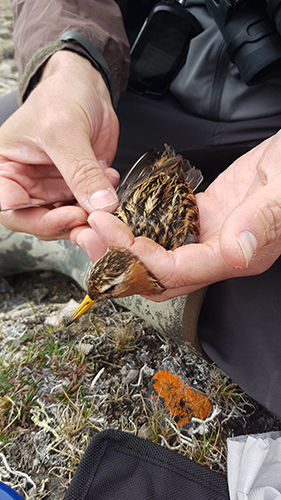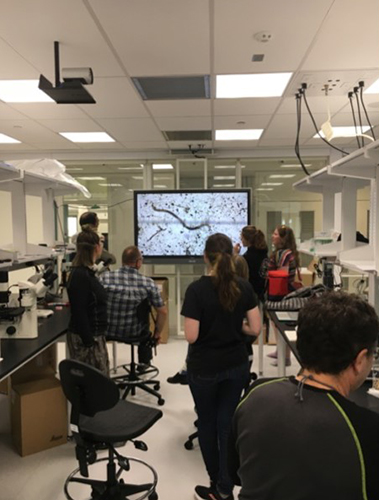- FROM THE TOP
- The Arctic-Boreal Vulnerability Experiment (ABoVE)
- Back to School and Other Anxieties for Children
- POLAR’S PEOPLE
- Nanuq the Polar Bear
- POLAR scientist co-authors paper on state of circumpolar muskox
- LEARNING AND PERFORMANCE
- Inuktitut/Inuinnaqtun Word of the Week - Kiinaujaq - ᑮᓇᐅᔭᖅ
- Are you ready to Talk the Talk?
- Check out POLAR’s Bird of the Week Column
- WORKPLACE NOTICES
- Accessing New Labs in the Main Research Building
- Information Management Tip of the Week
- UPDATES
- POLAR Events Calendar
- POLAR Priorities Update
- SOCIAL MEDIA HIGHLIGHTS
- Lots Happening on POLAR’s Social Media Channels
FROM THE TOP
The Arctic-Boreal Vulnerability Experiment (ABoVE)
A NASA aircraft packed with sophisticated remote sensing equipment is in Cambridge Bay this week as part of an ambitious international project to find out how vulnerable northern ecosystems are responding to a changing climate – and what that means for the people who depend on them.
POLAR is a collaborator in the 10-year NASA Arctic-Boreal Vulnerability Experiment (ABoVE), which uses data collected from cutting-edge airborne instrumentation and satellites, such as Canada’s RADARSAT-2, alongside the expertise of Indigenous communities and scientists in the field, to build understanding of how the environment in Alaska and the Northwestern Canadian Arctic is changing.
For this survey, NASA researchers will capture high-resolution infrared optical images of the tundra surface around Cambridge Bay. Meanwhile, field ecologists from POLAR and the University of Wisconsin will be on the ground making detailed studies of vegetation and ecosystems, creating baselines against which to measure future change.

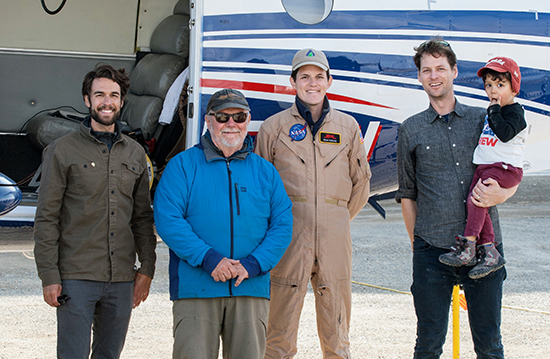
As part of this project, POLAR and NASA has invited the community to a viewing of the B200 aircraft and its AVIRIS-ng airborne equipment on Thursday, July 29 at the Cambridge Bay airport.
Radio Canada International, in collaboration with Eye on the Arctic, covered the airborne campaign. Read the article here: https://www.rcinet.ca/eye-on-the-arctic/2019/07/31/research-climate-nunavut-cambridge-bay/
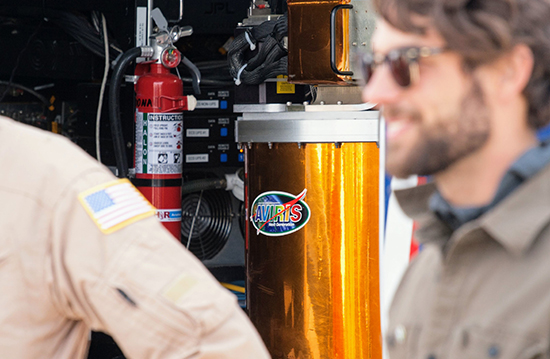
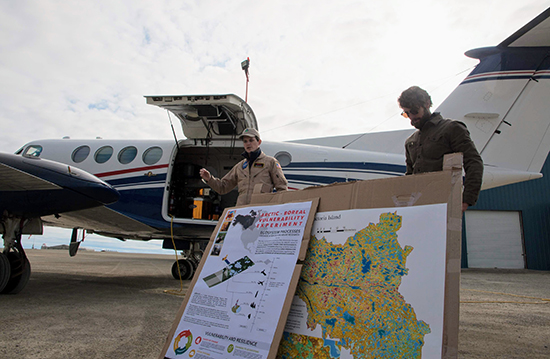
In addition, POLAR will hold an information session for the community at 11:00 a.m. on August 6th at the CHARS campus. During this session, scientists from POLAR and the University of Wisconsin will present ABoVE and its benefits for Arctic communities. For more info, please contact communications@polar.gc.ca.
Back to School and Other Anxieties for Children
After enjoying the summer vacation, some children may experience anxiety when it’s time to go back to school. The fear of the unknown and the adjustment to change may create worries. Several strategies are at parents’ fingertips to help their child overcome this transition. To learn more about these different approaches, you are invited to join the LifeSpeak “Ask The Expert” live Web Chat session on August 20, at 12:00 p.m. ET, where you or your immediate family member will have the opportunity to web chat with a child care expert, Sharon Selby, about children’s anxieties and receive an answer in real time within minutes. It’s an event to keep in mind so make sure to save the date in your agenda!
Date : August 20, 2019
Time : 12:00 p.m. ET
Expert : Sharon Selby, Registered Clinical Counsellor
Enjoy this and future Expert Web Chat sessions that are offered monthly on the LifeSpeak website.
Did you know you that the LifeSpeak App is now available for Android and iPhones in the App Store and on Google Play? Having this App will ensure that you will be notified of newly added resources and never miss the opportunity to join future LifeSpeak Web Chats.
Download the LifeSpeak app this way:
ACCESS THROUGH GROUP ACCOUNT
CLIENT NAME: canada
CLIENT PASSWORD: canada
For more information on other LifeSpeak resources, please visit:
WEBSITE ADDRESS: canada.lifespeak.com
ACCESS THROUGH GROUP ACCOUNT
PASSWORD: canada
This message is brought to you by the Employee Assistance Program (EAP) as a reminder to take care of your mental health. You can contact them 24/7 at 1-800-268-7708 or 1-800-567-5803 for the hard of hearing and the deaf.
POLAR’S PEOPLE
Nanuq the Polar Bear
Meet Nanuq the polar bear! This beautiful 10’ tall polar bear specimen, standing with paws up on an ice pan, is on loan to POLAR from the Ekaluktutiak Hunters & Trappers Organization. Want to know how this POLAR bear came about? Read the story below…
In April 2007, Willie Nakashook, a local guide, and members of his family were on a hunting trip in Hadley Bay in the far north of Victoria Island.
In between hunts, Willie’s family remained at their campsite. During one such stay they left to grab water for their reserves. Upon returning, at a distance away they could see a Polar Bear (Nanuq) roaming near the camp. Willie and his family did their best to scare Nanuq away using the sounds of their snowmobiles and gunshots fired into the air. However Nanuq refused to leave and after many hours they decided that for their camp’s safety, Nanuq would have to be put down.
The bear was brought back to the community and was turned over to the local wildlife department, as the shooting was determined to be a defensive kill. The remains of Nanuq were studied and it was found that he was near starvation.
Nanuq was on display at the Arctic Coasts Visitors centre for 11 years between 2008 and mid-2019. Want to admire this majestic animal species? He is located just outside the Knowledge Sharing Centre at the CHARS campus.
POLAR scientist co-authors paper on state of circumpolar muskox
How are muskoxen coping with an arctic climate that is getting warmer, wetter, and more variable? In a new paper in the journal Ambio, POLAR scientist Matilde Tomaselli and her Canadian and international colleagues from the Arctic Council’s Muskox Expert Network report on their groundbreaking work to improve understanding of these iconic northern animals. The group has made the first-ever compilation of current information on all 55 circumpolar muskox populations, which total about 170,000 animals. Six of these populations are declining, including the Victoria Island muskoxen, which are an important source of food and income for Inuit in Cambridge Bay, Kugluktuk, and Ulukhaktok.
The paper discusses muskox abundance and distribution, as well as health, genetic diversity, and causes of change. Factors linked to climate, diseases, and changes caused by humans are likely the main reasons. To bring stability to muskox populations throughout the circumpolar north, say the researchers, it is crucial to harmonize existing data, intensify and standardize long-term monitoring, and work more closely with local experts such as Inuit hunters with extensive knowledge of the animals. An example of this collaborative approach is the PhD research work of Matilde Tomaselli carried out in, and with active participation of, the community of Cambridge Bay. This work, recently featured in the journal Science, has increased understanding of muskox health in the Cambridge Bay area and serves as a model that can be applied to other wildlife species and settings.
LEARNING AND PERFORMANCE
Inuktitut/Inuinnaqtun Word of the Week - Kiinaujaq - ᑮᓇᐅᔭᖅ
The Inuinnaqtun/Inuktitut word of the week is “kiinaujaq”. It means “Money”.
It is pronounced: kee-na-oo-yaq
kiinaq /u/ jaq
face /be/ resemble

Listen to the pronunciation here.
Are you ready to Talk the Talk?

Check out POLAR’s Bird of the Week Column
The red phalarope (haavraq) is a small sandpiper, easily recognizable by its reddish plumage, dark cap and white cheek patch. This species is not as well-understood as many arctic shorebirds, due to its more remote nesting areas and a paucity of studies on breeding, wintering and migratory behaviour. Red phalaropes exhibit reverse sexual dimorphism, where females are larger and more brightly-colored than males. Males incubate eggs, and females frequently breed with more than one mate over the course of a single breeding season. As a circumpolar species, it inhabits arctic tundra, primarily in subarctic and northern Alaska. Its wintering range is poorly-understood, but includes coastal Chile and Peru.
In Cambridge Bay, the bird ecology team locates and monitors nests throughout the breeding season to understand their breeding timing, and tracks adult shorebirds to study their migratory behavior. In order to ensure the continued well-being of bird species living in a changing Arctic, researchers must establish baseline data on their distribution and abundance. The red phalarope was a rare sight in Cambridge Bay this year, with only three individuals sighted over the course of the summer.
WORKPLACE NOTICES
Accessing New Labs in the Main Research Building
POLAR researchers and visiting scientists now have access to the Teaching Lab and Reference Collections, Digital Imaging Lab and General Computing Lab (GCL) in the Main Research Building. The access to these labs will allow us to significantly expand our ability to support research during this busy summer field season.
POLAR hosted a course run by Olivia Mussells from Oceans North, in its General Computing Lab (GCL) last month. The course trained nine local Inuit through the Hunter and Trappers Organization (HTO) in the use of locally-relevant marine/maritime information service. The course was successful, owing largely to the GCL performing on or beyond every expectation.
The GCL has also been used to re-engineer and enhance ATV parts for the Science and Technology Operations team. Several parts have been successfully built, installed, and utilized in the ATVs. Here, 3-D printed parts are hardened and strengthened in a ultraviolet reactor.
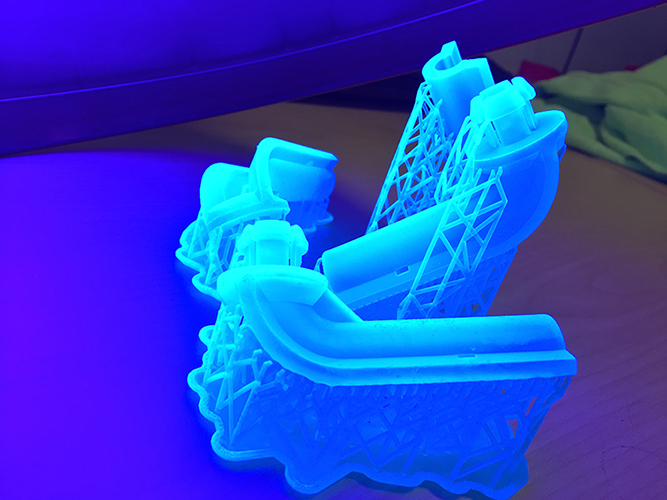

The GCL will be expanding its engineering materials library to better serve the needs of the Ops team. POLAR hopes to select some members for training on the manufacturing skills.
Information Management Tip of the Week
Imagine if we could take all our files from the whole organisation and put them into one single folder. Could we still quickly filter down to what we want by scrolling through the file list?
This is what Naming Conventions allow us to do.
This file naming convention is a systematic method for naming our files. It is the most powerful and easy method for organising and retrieving our documents.
- This will not only increase the readability of the filename itself, but also:
- Allow us to know the content of a document without opening it
- Retrieve and filter documents quickly using the search/filter function of the computer
- Store documents in a single folder without losing their context, if we need to
- Find and identify documents even if they are no longer in their original folder
- Easily browse long lists of files to inventory or check for missing documents

- Use a name that clearly describes the content of the document – this will make it easier for you and your colleagues to find it in GCdocs.
- Use the mandatory elements Subject and Document type to ensure clear, easy-to-understand document names.
- Use the optional elements Date and Status in the document name only if they are necessary for additional clarity.
For more information, please contact Renée at renee.bergeron@polar.gc.ca.
UPDATES
POLAR Events Calendar
You will find below the latest version of the POLAR events calendar, including upcoming events and conferences for your information.
Note: The calendar is subject to change. Any travel has to be pre-approved by Directors (and above for international destinations).
Please send any calendar updates or additions to Jerry Kallada at jerry.kallada@polar.gc.ca
POLAR events calendar: July 31, 2019
POLAR Priorities Update
The latest Priorities Update document is here. Take a look at the priorities and activities of your colleagues between July 29 to August 23.
SOCIAL MEDIA HIGHLIGHTS
Lots Happening on POLAR’s Social Media Channels

- POLAR's bird ecology team surveys sites near Ovayok Territorial Park (NU)
- Ian Military attachés with the US Embassy in Ottawa toured the CHARS campus

- POLAR welcomes reps from various GoC departments at the CHARS campus
- POLAR attends the Council of Managers of National Antarctic Programs in Bulgaria

- Community members in Cambridge Bay view NASA’s B-200 remote-sensing aircraft as part of ABoVE
- POLAR hosts UBC’s Arctic Ecology field course at the CHARS campus



